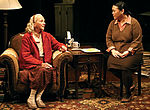Hippotheatron
1864 establishments in New York (state)1872 disestablishments in New York (state)Buildings and structures demolished in 1872CircusesCommercial buildings completed in 1864 ... and 5 more
Demolished buildings and structures in ManhattanDemolished theatres in New York CityPages containing links to subscription-only contentSource attributionTheatres completed in 1864

The Hippotheatron was an entertainment venue in New York built for large-scale circus and equestrian performances although ballets, dramas and pantomimes were also held there. Opened in 1864, it was destroyed by fire in 1872 which resulted in the death of most of the animals in the menagerie.
Excerpt from the Wikipedia article Hippotheatron (License: CC BY-SA 3.0, Authors, Images).Hippotheatron
East 14th Street, New York Manhattan
Geographical coordinates (GPS) Address Nearby Places Show on map
Geographical coordinates (GPS)
| Latitude | Longitude |
|---|---|
| N 40.734 ° | E -73.9895 ° |
Address
10 Union Square
East 14th Street
10003 New York, Manhattan
New York, United States
Open on Google Maps










